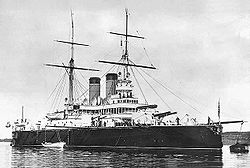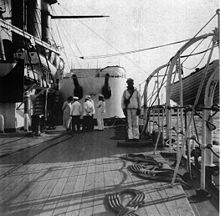Rostislaw (ship)
|
The Rostislav c.1901
|
||||||||||||||
|
||||||||||||||
|
||||||||||||||
|
||||||||||||||
|
||||||||||||||
The Rostislaw (Russian: Ростислав) was the seventh of eight unit ships of the Imperial Russian Navy , which was built as part of the 20-year program for the establishment of the Black Sea Fleet . It was designed as a smaller ship with strong artillery armament, low displacement and good seaworthiness for use in coastal areas of the Black Sea .
History and construction
The tactical-technical task was handed over from the Navy Ministry under Admiral NM Tschichachev to the Commander-in-Chief of the Black and Caspian Sea and Black Sea Ports, Vice Admiral NW Kopytow. It proposed developing four to five smaller but adequately armed ships with a total displacement of no more than 24,000 tons. The chief engineer of the Naval War Port of Nikolajew , SK Ratnik, rated the proposed size as no longer appropriate. Instead, he proposed four designs with a displacement of 4,750 to 6,000 tons and a speed of 16 knots. He increased the main armament in a twin turret from 22.9 cm to 30.5 cm, the armor was reinforced and two 15.2 cm rapid-fire cannons were to be installed.
The members of the Naval Technical Commission (MTK) compared the drafts submitted by Ratnik with the drafts of the battleships Gangut (Гангут) and Sisoi Veliki (Сисой Великий). In their opinion, all elements of a battleship were optimally connected to one another in the 6,000-tonne designs. The naval minister Tschichachev instructed the new chief engineer of the naval port of Nikolayev, AP Toropow, who was currently in St. Petersburg and who had replaced Ratnik, to create a new project. The armament should be placed entirely in turrets. Armor and speed should match that of modern battleships. The project presented provided for four 25.4 cm cannons in two twin towers, eight 15.2 cm cannons in single towers, a belt armor of 356 mm, a displacement of 7,500 t and a speed of 15.2 knots. On the basis of this project, Tschichachev commissioned a variant in which, instead of two 254 mm cannons, one 305 mm cannon per tower was provided. Taking into account a reserve of 200 t, the displacement increased to 7,700 t. Toropov had provided the reserve because the Russian 30.5 cm cannon had larger dimensions and weights than the French cannons originally planned in the project. By installing water tube boilers instead of the originally intended flame tube boilers , the engine output was to be increased from 7,000 to 8,400 hp, and the projected speed rose to 16.2 knots. Admiral General Grand Duke Alexei Alexandrovich Romanov , however, saw it as cheaper to use 25.4 cm cannons on the battleship, as Tschichachev noted in his diary.
The transition from the simple but maintenance-intensive hydraulic to the electric tower slewing gear was undoubtedly a progressive element of the ship, but made the completion of the ship more difficult due to the innovations. The armored turrets for the 25.4 cm cannons were manufactured by the Obuchow factory , while the armor made of nickel steel with a total weight of 1,227 tons was manufactured by the Bethlehem Iron Company .
For the first time in Russian shipbuilding, the use of oil-fired water-tube boilers was planned for the ship. Due to delays in their production, however, structurally obsolete flame tube boilers were installed.
On May 7, 1894, the ship with the name Rostislaw was officially entered in the fleet list. The ship was laid on May 6, 1895, the launch took place on August 20 of the following year. MK Jakowlew was appointed chief engineer for the construction, and captain 1st rank AM Spitsky was appointed commander. When the ship went into service, the crew consisted of 15 officers and 11 specialists who were on an equal footing with the officers but did not have a military rank (five mechanical engineers, two doctors and four administrative officers), as well as 606 non-commissioned officers and men.
commitment
From May 1, 1900 to January 1, 1903, the ship was under the command of Grand Duke Alexander Mikhailovich Romanov . In 1905 the battleship took part in the suppression of the mutiny of the Black Sea Fleet, in particular in the bombardment of the cruiser Ochakov (Очаков).
On October 10, 1907, the Rostislaw was reclassified as a ship of the line .
In May 1909 rammed and sank the Rostislaw in the harbor entrance of Sevastopol , the submarine Kambala ( "Камбала"). The officer on watch of the ship of the line, Lieutenant Aquilonov, was found guilty.
The Rostislav took part in the First World War. She took part in the bombardment of the Turkish coast and the blockade of Turkish seaports as well as in the Ezrum operation from January 10 to February 14, 1916 and in the Trapezunter operation from February 5 to April 18, 1916, and in the defense of Constanța in October 1916 .
On January 8, 1918, the ship was incorporated into the Red Black Sea Fleet. During the civil war, the Rostislaw was involved in the establishment of Soviet power in Odessa from January to March 1918. From March 1918 on, the ship was in the naval port of Odessa, where it was taken over by the German occupiers on May 1, 1918. On November 24, 1918, it became the property of the Anglo-French intervention forces. From April 22 to 24, 1919, it was partially disarmed and decommissioned on the orders of British commanders. On April 24, the ship was taken over by units of the Ukrainian Front of the Red Workers and Peasants Army , and on June 24 of that year it returned to the possession of the White Guards. From these it was led as a block ship in the fleet of southern Russia. In November 1920, the ship was sunk at JenISCHE to block the Kerch Strait . In 1930 the EPRON (ЭПРОН) lifted parts of the armament and equipment.


